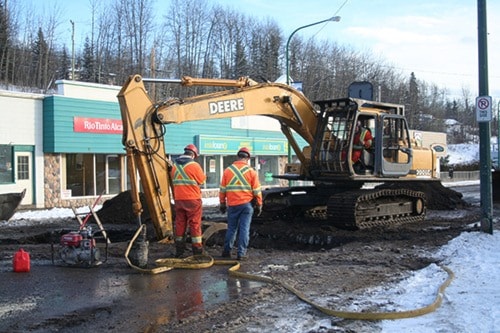The Federation of Canadian Municipalities (FCM) has been the ‘national voice of municipal government’ since 1901. On Nov. 13 the FCM released a report of card of sorts regarding the state of infrastructure in cities and towns across the country.
After surveying over 300 communities, large and small, across the country the FCM came to the conclusion that while it’s not time to panic, there are serious issues to be dealt with. The FCM calls for a 20 year plan between all levels of government to deal with ‘cruwambling infrastructure.”
In identifying municipal infrastructure assets that rate between fair to very poor conditions, the report estimates that 30 per cent, or $171.8 billion dollars worth of repairs and maintenance, need to be done at a municipal level.
This cost includes maintenance and upgrades to roads, sewage, drinking water and stormwater management systems, and it adds up to $13,813 in debt that every household in Canada carries in infrastructure liability.
Rick Martin, Village of Burns Lake Director of Public Works, is well aware of the hidden problems facing Burns Lake. “Some of the issues are aging pumps and motors, underground piping, streets and roads,” he said. “Costs will be determined when the asset management program is complete, but it will be in the millions of dollars.”
The asset management plan is a comprehensive survey of the state of municipal infrastructure along with costs and timelines for replacement or upgrades.
Martin said that the plan uses software to model data inputs including ‘asset type, location, original cost, and replacement cost’. “It will allow us to track investment and changes in our assets, and to plan for replacement based on several criteria,” he said.
While the asset management plan won’t be ready for review until spring 2013, this doesn’t mean that village councillors are not in tune with the problems Burns Lake faces.
When coun. Susan Schienbein was first elected to council in 2003 she started asking questions about the plan for maintaining the village’s roads and sewers.
“For me, it was a bit like being a first time homeowner,” she said. “How old is the roof? How long will it last? How much will it cost me to repair it?”
Schienbein concerns were confirmed to be shared by residents who came out for the village budget town hall held on Nov. 13. Many placed sewers, roads and drinking water as being top priorities for the village in terms of focus and responsibility.
The village is in the midst of a three phase downtown revitalization project designed to beautify the downtown core, to attract investment and to make the village more liveable for all.
Schienbein appreciates the importance of this kind of work, but she is concerned that the residents of Burns Lake fully understand the debt load that the tax base is potentially facing.
“The tax-payers of Burns Lake need to understand that infrastructure is the foundation of our community,” Schienbein said. “We cannot expect to attract businesses or professionals or retain segments of our population if we aren’t able to maintain infrastructure.”
Not to draw too fine a point on it, Schienbein asked, “If you flush your toilet and water doesn’t go anywhere - will anyone care how many flowers are planted downtown?”
No elected official anywhere wants to be caught without the resources in place to deal with public works problems. Both Prince George city council and Terrace town council are considering tax increases in order to deal with decaying infrastructure.
Some eventual sitting council of the Village of Burns Lake will feel the hammer drop on one of more public works project.
“Residents need to understand that the point when we have to deal with this might be here sooner than we would like to think,” said Schienbein as she listed basic infrastructure like pumping stations, sewage treatment ponds, culverts, roads and bridges as all having 25 to 75 years of life expectancy, depending on the item.
“Burns Lake celebrates its ninetieth birthday next year,” she said. “Where might that hammer be?”
